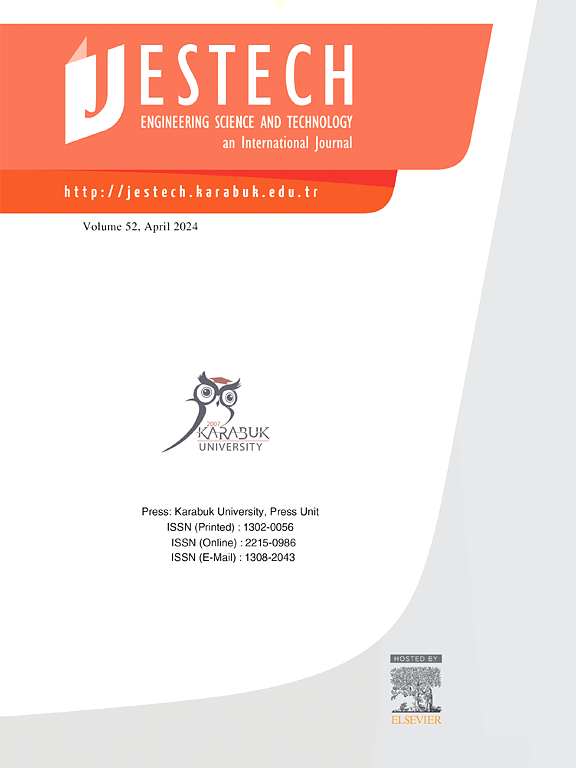Experimental investigation of the performance and energy consumption efficiency of elliptical gear hydraulic pump and evaluation by Taguchi method
IF 5.1
2区 工程技术
Q1 ENGINEERING, MULTIDISCIPLINARY
Engineering Science and Technology-An International Journal-Jestech
Pub Date : 2025-02-01
DOI:10.1016/j.jestch.2024.101941
引用次数: 0
Abstract
This study presents an approach based on the Taguchi method to evaluate the energy consumption performance of spur and elliptical gear hydraulic pumps. Output flow is one of the essential indicators of gear pump performance. Taguchi L8 experimental design with two factors and mixed level design was applied to determine the gear pump performances. Rotational speed (200, 600, 1000 and 1400 rpm) and pump type (spur and elliptical) is selected as experimental parameters. Thus, the effect of the rotational speed of an elliptical gear pump on the gear pump flow and energy consumption performance is experimentally analyzed. The results of the analysis showed that the elliptical gear pump delivered approximately 120 % higher volumetric flow rate. In terms of pressure performance, the elliptical gear pump showed an advantage of around 87 %, providing higher pressure, especially at low speeds. In terms of energy consumption, the elliptical gear pump has been experimentally proven to consume approximately 145 % less energy at low speeds. It is also found that there is less temperature difference in the hydraulic fluid during operation of the elliptical gear pump. In addition, the elliptical gear pump exhibited a similar behavior tendency under high-loads as in the partia-loaded case.Elliptical gear pump can be said to be a new type of volumetric pump, which is better than the commonly used spur gear pump, especially in terms of output flow and energy consumption performance.
椭圆齿轮液压泵性能与能耗效率的实验研究及田口法评价
提出了一种基于田口法的直齿和椭圆齿轮液压泵能耗性能评价方法。输出流量是齿轮泵性能的重要指标之一。采用双因素田口L8试验设计和混合水平设计确定齿轮泵的性能。实验参数选择转速(200,600,1000和1400rpm)和泵型(直齿和椭圆)。为此,实验分析了椭圆齿轮泵转速对齿轮泵流量和能耗性能的影响。分析结果表明,椭圆齿轮泵提供了约120%的高容积流量。在压力性能方面,椭圆齿轮泵显示约87%的优势,提供更高的压力,特别是在低速。在能源消耗方面,椭圆齿轮泵已被实验证明,在低速消耗约145%的能量。还发现椭圆齿轮泵在工作过程中,液压油的温度差较小。此外,椭圆齿轮泵在高载荷情况下表现出与局部载荷情况相似的行为趋势。椭圆齿轮泵可以说是一种新型的容积泵,它比常用的正齿轮齿轮泵要好,特别是在输出流量和能耗性能方面。
本文章由计算机程序翻译,如有差异,请以英文原文为准。
求助全文
约1分钟内获得全文
求助全文
来源期刊

Engineering Science and Technology-An International Journal-Jestech
Materials Science-Electronic, Optical and Magnetic Materials
CiteScore
11.20
自引率
3.50%
发文量
153
审稿时长
22 days
期刊介绍:
Engineering Science and Technology, an International Journal (JESTECH) (formerly Technology), a peer-reviewed quarterly engineering journal, publishes both theoretical and experimental high quality papers of permanent interest, not previously published in journals, in the field of engineering and applied science which aims to promote the theory and practice of technology and engineering. In addition to peer-reviewed original research papers, the Editorial Board welcomes original research reports, state-of-the-art reviews and communications in the broadly defined field of engineering science and technology.
The scope of JESTECH includes a wide spectrum of subjects including:
-Electrical/Electronics and Computer Engineering (Biomedical Engineering and Instrumentation; Coding, Cryptography, and Information Protection; Communications, Networks, Mobile Computing and Distributed Systems; Compilers and Operating Systems; Computer Architecture, Parallel Processing, and Dependability; Computer Vision and Robotics; Control Theory; Electromagnetic Waves, Microwave Techniques and Antennas; Embedded Systems; Integrated Circuits, VLSI Design, Testing, and CAD; Microelectromechanical Systems; Microelectronics, and Electronic Devices and Circuits; Power, Energy and Energy Conversion Systems; Signal, Image, and Speech Processing)
-Mechanical and Civil Engineering (Automotive Technologies; Biomechanics; Construction Materials; Design and Manufacturing; Dynamics and Control; Energy Generation, Utilization, Conversion, and Storage; Fluid Mechanics and Hydraulics; Heat and Mass Transfer; Micro-Nano Sciences; Renewable and Sustainable Energy Technologies; Robotics and Mechatronics; Solid Mechanics and Structure; Thermal Sciences)
-Metallurgical and Materials Engineering (Advanced Materials Science; Biomaterials; Ceramic and Inorgnanic Materials; Electronic-Magnetic Materials; Energy and Environment; Materials Characterizastion; Metallurgy; Polymers and Nanocomposites)
 求助内容:
求助内容: 应助结果提醒方式:
应助结果提醒方式:


